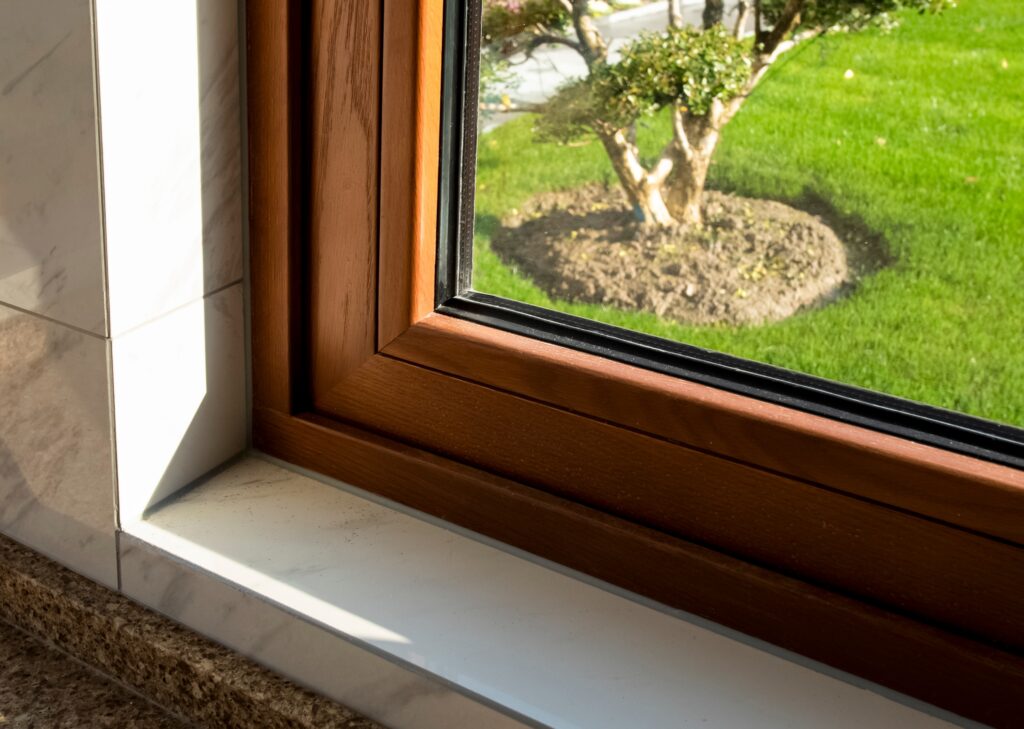A Step-by-Step Guide to Repairing Wood Windows with Rotting Wood

Wood windows bring warmth and character to a home, but they’re not invincible. Over the years, constant exposure to rain, humidity, and changing seasons can take a toll. Add in a little age or skipped maintenance, and you may start spotting soft spots, peeling paint, or worse—rotting wood windows.
The tricky part is that rot doesn’t fix itself, and the longer you wait, the more damage spreads. What starts as a small patch on a sill can quickly turn into a costly replacement job. That’s why repairing wood windows early is so important. With the right tools, a little patience, and some know-how, you can handle wood window repair yourself, save money, and keep your home looking its best.
In this guide, we’ll walk through a step-by-step process to help you spot rot, repair it, and protect your windows so they last for years to come.
Understanding Wood Window Rot
Wood windows can last for decades if they’re cared for properly, but once rot sets in, things can go downhill fast. Knowing what causes rot—and how to spot it early—gives you a better chance of fixing the problem before it gets out of hand.
Common Causes of Wood Rot
- Excessive moisture exposure
Wood and water don’t mix well. Rain, humidity, and condensation can seep into cracks or unsealed areas, creating the perfect environment for rot. - Poor drainage around windows
If water isn’t directed away from your windows, it will pool and eventually soak into the wood. Clogged gutters, missing flashing, or sloped siding can all make the problem worse. - Lack of paint or sealant maintenance
Paint and sealant act like armor for your wood windows. When they peel, crack, or wear away, the bare wood underneath is left exposed to the elements. - Insect damage
Termites and carpenter ants love damp, weakened wood. Once pests move in, they accelerate the rot and make repairs more urgent.
Signs Your Window Has Rot
- Soft, spongy wood around sills or frames
Press gently on suspicious areas. If the wood feels soft or gives way, that’s a red flag for rot. - Peeling paint or bubbling finish
When moisture gets trapped under paint, it causes bubbling, flaking, or peeling. That’s often a sign something is going on underneath the surface. - Visible mold, mildew, or discoloration
Dark streaks, patches of mold, or musty smells usually point to excess moisture—and potentially rotting wood. - Drafts and difficulty opening/closing
If your windows stick, won’t close properly, or let in a breeze, rot may have warped the frame.
Tools and Materials Needed
Before you dive into repairing wood windows, it’s smart to have everything you’ll need ready to go. The right wood window repair materials not only make the job easier but also ensure your repair actually lasts. Here’s a breakdown of the basics:
- Safety gear (gloves, goggles, mask)
Rot repair can get messy—between dust, old paint, and possibly mold, you’ll want to keep your eyes, hands, and lungs protected. - Screwdriver, pry bar, chisel
These are your go-to tools for removing damaged wood and loosening any trim or pieces that need to come out. A chisel is especially handy for carefully scraping away rotted spots without damaging the surrounding frame. - Wood filler or epoxy consolidant
For small to medium repairs, this is what you’ll use to rebuild missing sections. Wood filler is great for shallow spots, while epoxy consolidant is stronger and better for stabilizing larger areas of rot. - Replacement wood pieces (if needed)
If part of the frame or sill is too far gone, you’ll need fresh lumber to swap in. Try to match the type and size of the original wood for a seamless repair. - Sandpaper and putty knife
After filling or patching, you’ll need to smooth things out. A putty knife helps apply filler evenly, and sandpaper gets the surface ready for painting. - Primer, exterior paint, and caulk
These finishing materials seal and protect your repair. Primer helps the paint stick, exterior paint shields against the elements, and caulk keeps water from sneaking back in through gaps.
Having these tools on hand means you can move step by step without interruption—and it gives your repair the best shot at holding up against time and weather.
Step-by-Step Process to Repair Rotting Wood Windows
Repairing rotting wood windows isn’t as intimidating as it sounds—especially if you break it down into manageable steps. Here’s how to tackle the job like a pro.
Step 1 – Inspect the Damage
Start by giving your window a careful once-over. Press gently on the sill, frame, and trim to see if the wood feels soft or spongy. If the rot is just on the surface, you can usually repair it yourself. But if the damage goes deep into the frame or affects the structure of the window, you may need to replace sections—or even the entire window. Taking time to assess now saves you from wasted effort later.
Step 2 – Remove the Rotten Wood
Next, grab your chisel, pry bar, or multi-tool and carefully cut out the bad wood. Work slowly so you don’t gouge the surrounding good wood. The goal is to get rid of every crumbly, weak spot while keeping the healthy sections intact. Think of it like dental work—you’re cleaning out the cavity before you can fill it.
Step 3 – Treat and Stabilize the Area
Once the rotten wood is out, it’s time to strengthen what’s left. Brush or inject a wood hardener into the exposed area. This stuff soaks in and reinforces the remaining fibers, giving you a solid base to build on. Bonus: it also helps seal the area against future moisture damage.
Step 4 – Fill or Replace
Now comes the rebuild. For small to medium patches, apply an epoxy wood filler and shape it to match the original profile. For larger sections that are too far gone, cut new pieces of wood to fit and secure them in place. Either way, you’re restoring the structure so your window can function like it should.
Step 5 – Sand and Smooth
After the filler cures or the replacement piece is secure, it’s time to smooth everything out. Use sandpaper to level the repair so it blends seamlessly with the surrounding wood. The smoother the surface, the better your paint job will look later.
Step 6 – Prime, Paint, and Seal
The finishing touch is all about protection. Brush on a quality primer first, then cover it with durable exterior paint. Be sure to caulk the edges and seams so water can’t sneak back in. Not only does this step make your repair look sharp, but it also boosts weather resistance and energy efficiency, keeping drafts out and your home comfortable.
When to Repair vs. Replace Wood Windows
One of the trickiest parts of dealing with rotting wood windows is deciding whether a quick repair will do the job—or if it’s time to throw in the towel and replace them altogether. Here’s how to make the call.
Minor Rot
If you catch the problem early, you’re in luck. Small patches of rot on a sill or frame can usually be handled with some filler, epoxy, and paint. These fixes are inexpensive, straightforward, and extend the life of your window without too much hassle.
Multiple Sections Rotting
When you’ve got rot showing up in several spots, or it’s spread deep into the structure of the window, repairs start to lose their value. In cases like this, it’s usually smarter to call in a pro and look at replacement. New windows may cost more upfront, but they’ll last longer and give you better energy efficiency.
Cost Comparison: Replace vs Repair
A DIY repair might run you anywhere from $20 to $100 in materials, while hiring a contractor for more serious patchwork could cost several hundred dollars. Replacing a single wood window, on the other hand, often ranges from $500 to $1,200 depending on the style and quality. If your repairs are adding up close to the price of a new window, replacement may be the more practical long-term choice.
Repairs make sense for small, contained damage, but if the rot is widespread—or if your windows are already old and drafty—replacement may save you money and frustration in the long run.
Preventing Future Rot
Once you’ve put the work into fixing rotting wood windows, the last thing you want is to deal with the same problem all over again. A little routine maintenance goes a long way toward keeping rot at bay.
Regular Maintenance
Think of paint and sealant as your windows’ raincoat. Over time, that protective layer wears down, leaving the wood exposed. Make it a habit to check your windows once or twice a year. If you spot peeling paint, cracks, or bare wood, touch it up before moisture sneaks in.
Keep Gutters Clear
Clogged gutters don’t just make a mess—they send water spilling down your siding and into your windowsills. Keep those gutters clean and make sure downspouts direct water away from your home.
Storm Windows or Protective Flashing
If your home gets hammered by heavy rain or snow, adding storm windows or flashing gives your wood windows an extra layer of defense. They block moisture, reduce drafts, and can even help with energy efficiency.
Use Treated or Rot-Resistant Wood
When replacing sections of a window—or installing new ones—choose treated lumber or naturally rot-resistant woods like cedar or redwood. They’re more resistant to moisture and pests, giving you longer-lasting protection.
By taking these simple steps, you’ll stretch the lifespan of your wood windows, keep them looking sharp, and save yourself from repeat repair jobs.
FAQs
How long does a wood window repair last?
If done right—with solid prep, quality filler or epoxy, and a good paint job—a repair can last anywhere from 5 to 10 years. The key is keeping up with maintenance so moisture doesn’t sneak back in.
Can I repair window rot myself or should I hire a pro?
Small spots of rot are totally DIY-friendly if you’re comfortable with basic tools. But if the damage is widespread, involves multiple windows, or affects the structural frame, bringing in a pro is the safer (and often more cost-effective) move.
What’s the best filler for wood window rot?
For shallow damage, a simple wood filler works fine. For deeper rot, epoxy filler or a consolidant is the gold standard—it’s stronger, bonds well, and can be shaped to match the original wood.
Will repairing improve energy efficiency?
Yes! Rot creates gaps and weak spots that let air slip in and out. Sealing those areas during a repair reduces drafts, helps regulate indoor temps, and can even lower your energy bills.
Conclusion
Repairing rotting wood windows might sound like a hassle, but it’s one of those projects that pays off big time. By tackling repairs early, you can save money, extend the life of your windows, and keep your home’s curb appeal intact. Plus, you’ll avoid the bigger structural issues that come with letting rot spread unchecked.
If you notice soft spots, peeling paint, or other signs of damage, take action right away. A quick fix today can save you from an expensive replacement tomorrow.
Contact a local window repair contractor for a professional inspection. Even if you’re planning a DIY job, having a pro take a look can give you peace of mind—and make sure you’re on the right track.

Anna has over six years of experience in the home services and journalism industries and serves as the Content Manager at MyHomePros.com, specializing in making complex home improvement topics like HVAC, roofing, and plumbing accessible to all. With a bachelor’s degree in journalism from Auburn University, she excels in crafting localized, comprehensive guides that cater to homeowners’ unique needs. Living on both coasts of the United States has equipped her with a distinctive perspective, fueling her passion for turning any house into a cherished home through informed, personalized decision-making.








